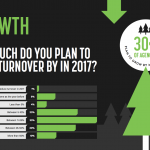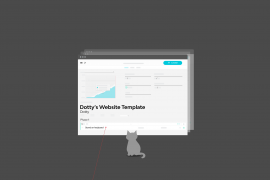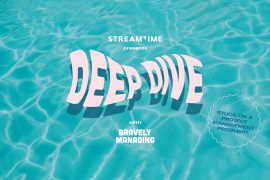Whether you’re a freelancer or work in an agency, tracking your time may be a necessary evil. Equally, if you run your own studio, you may have to track your team’s time to run an efficient business. Not everyone likes having to fill in timesheets, of course, especially because they’re time-consuming and not accurate, but there’s no denying that time-tracking can boost your productivity.
We talked to a whole range of industry experts — designers, creative directors, consultants, project managers, and asked them about their approach to time-tracking. Interestingly enough, a lot of them share Streamtime’s mantra to kill timesheets and don’t do time-tracking in the traditional sense. Everyone uses different systems. Some people even just keep track of hours in a text file!
“Time-tracking is helpful early in a person’s career, so they can gauge how long things take,” Brian Hoff, founder and creative director of Brian Hoff Design, explains. “But the longer you do this line of work, you have an understanding of time and think more in terms of structuring the day around projects that are designed to meet financial goals.”
So how do you track time like a pro? Here’s what our 13 experts had to say:
1. Project your time
Kevin Hoffman, founder of Seven Heads Design, describes his approach as more ‘time projection’ than time-tracking.
“I put my deadlines in my work calendar as events with the estimated hours to finish them,” he explains. “If it’s multi-day, I block the working time needed.”
Irene Pereyra, one half of Brooklyn-based design studio Anton & Irene, favours a similar method:
“I block off hours in my calendar for specific tasks and try to stagger them, so I can switch between tasks that require more mental effort, boring administrative tasks or production heavy hands-on work. That way if I get stuck in one of the tasks or I get bored, I can easily switch it up and move the ‘blocks’ in my calendar around.”
Catt Small, a product designer at Etsy, also blocks off time in Google Calendar to ensure she can properly focus on one specific task for a set amount of time. She explains: “This also helps me understand how much time I spend on work for different projects and determine if I need to let go of any obligations that might cause more stress than success.”
Rachel Gertz, digital project manager trainer and co-founder of studio Louder Than Ten, meanwhile, recommends looking for patterns in the types of tasks you complete.
“Watch to see if tasks take longer at certain times of the day or if certain types of tasks take twice as long as you think,” she suggests. “If you can create a baseline, you can make gentle tweaks to help you be more accurate in your estimates, one variable at a time.”
And Emily Berens, project management professional and Westwerk director of operations and culture, recommends to “block off time for internal and client meetings, as well as any project or administrative tasks that you plan to work on. This helps to not only provide structure to your days, but is also a good resource to assist in your time logging efforts. Don’t forget to schedule in breaks for yourself!”
2. Stick to a block schedule
Brian Hoff tends to stick to a block schedule. He divides up his eight-hour day more or less the same every week. Here’s an example:
8-9am: Emails, business management tasks (invoicing, call scheduling, etc), answering Slack messages I might have missed…
9-11:30am: Heads down work for two hours on a given project. Having this large chunk of time allows my brain to get deep into thought and crank out as much as possible without interruption.
11:30am-12pm: I leave this open every day for 15-minute blocks for potential new clients calls or follow up discussions. If I don’t have any calls that day, I’ll prep some future email campaigns I send out monthly or jump into emails again.
1pm-3:30pm: After getting my grub on, I’ll again jump into another project (or the same from above) for another good 2+ hour stretch.
3:30-4pm: Another block of time I leave open for 15-min phone calls for new business leads.
4-5pm: Tidying up anything from the days projects I’ve worked on.
5-5:30pm: End of day communication: let clients know where things are at, if I need anything from them, Respond to Slack messages, etc.
After 6: Dad mode. Eat. Sleep. Repeat.
3. Set up tools to remind yourself
Fabio Benedetti, a senior designer and illustrator currently working for Apple, says that “time-tracking is fundamental, especially if you are a busy freelancer and you want to monetize your time in a thoughtful way.”
He uses calendar app Fantastical 2 by Flexibits to remind himself of every deadline, while Anna Debenham, front-end developer at Snyk, recommends setting up Slack to write yourself notes.
“Sometimes you don’t need to keep track of every minute,” she says. “If you use Slack, you can write messages to yourself in your own channel. You can use this as a really simple way to keep track of what you’re doing. Every time you switch tasks, write yourself a quick note. Or, if you’re prone to forgetting, set yourself a daily reminder like this:
remind me “what have you worked on today?” every weekday at 5pm
No more struggling to remember what you did yesterday in the daily standup!”

Fantastical 2 is a full Mac app that’s also available for the iPhone, iPad and Apple Watch
4. Use to-do lists
Streamtime has stripped timesheets out and introduced auto-populated to-do lists, which are a lot more popular, make time-tracking significantly easier to manage, and are more in line with how people actually think. These days we expect machines to do all the work for us, so why should people fill out timesheets if they could be automated?
Benedetti also loves Things by Cultured Code, a task manager that he uses as a to-do list to remember every single task in his busy schedule.
Pereyra, meanwhile, never uses apps or the computer for to-do lists. “For every project, have a very detailed and specific handwritten to-do list,” she explains. “I also write down all of my tasks on sticky notes and past them to the bottom of my monitor. Whenever I complete a task, it feels great to cross them out, and remove the sticky note from my monitor.”

Streamtime shifts the focus from specific time-tracking to to-do lists.
5. Use time-tracking apps
Apart from Streamtime, there are many other time-tracking apps to choose from. One that was mentioned a few times by the experts we talked to is Toggl.
“It is a very intuitive and easy-to-use application,” enthuses Benedetti. “Their user interface is clean and straightforward and you can also track your time in a visual way by checking the visual charts in the report section. A must have!”
Matt Hamm, creative director, illustrator and designer of Supereight Studio, however, is not so sure. “I really don’t like tracking my time,” he sighs, “so if I have to do it, I want to use something which requires as minimal effort as possible. Currently I’m using the free version of Toggl. It’s ok, but there are plenty of things I would change about the UI. I like the fact that the timer goes idle after a while if you don’t use your computer and then asks if you want to log that time or discard it. I’m not very good at remembering to turn time-tracking on let alone turning it off.”
Catt Small, meanwhile, swears by Rescue Time:
“It’s a tool that tracks how much time I spend using apps and websites on my computer, which I find helpful for ensuring that I don’t spend more time reading social media than working on things I want to accomplish.”

Toggl is very popular for tracking your time but not everyone’s happy with the UI
6. Make time-tracking as simple as possible
If you run a business, time-tracking is a valuable operational exercise, as long as you make the time to actually review the data you collect. Timesheets, however, can be very cumbersome and unproductive and are prone to doctoring by staff members.
All the project management experts we interviewed for this article recommended keeping time-tracking simple, a sentiment that’s shared by Streamtime, which has put a lot of research into making the new app easy-to-use for anyone involved in project management. Being able to track your time when out and about (via your mobile) is a huge bonus too!

“The best way to get time tracking adopted by staff is to make it easy to enter and as non-intrusive to their work day as possible,” explains Dave DeRuchie, client success director at web design and consulting agency Happy Cog.
Amy Kapell, VP of client strategy at California digital agency Closed Loop, couldn’t agree more.
“By its very nature, time-tracking is interruptive,” she exclaims. “It requires you to step out of your zone and account for how you just spent your time. As such, if your time-tracking requires you to log in to another tool, make choices between multiple drop-downs, then make some comments and THEN finally enter your time, there’s a high likelihood you’ll fall off the time-tracking bandwagon. Instead, look for ways to make your time-tracking as simple as possible (do you really need ALL those drop-downs?) and as integrated into your current workflow as you can. My team uses a plugin that allows them to enter time within the actual project card on which they’re working.”
Digital project management consultant Brett Harned favours a very similar approach.
“Don’t get bogged down in details,” he explains. “Unless you need heavy reporting on how long it takes to complete a single task, keep your time tracking codes high level. For instance, do you need to know how long it took one person to create a homepage design, or do you just need to know how much time the whole design process—reviews, presentations, and working time included—takes for a team? Using a “Design” code in your time tracking system rather than “Design”, “Design Brainstorming ”, “Design Presentation”, etc simplifies the work required to track time accurately. The easier you can make it on people, the more accurate their timesheet will be.”
7. Round up your time
It can be really difficult to track your time to the minute.
“So why bother expecting that?,” Brett Harned asks. “Set a rule that if you don’t have a timer running, round your time to 15 minute increments. That will remove some unneeded stress for some people.”
Rachel Gertz agrees: “Minutes and hours aren’t that important. Days and weeks are boxes of time that tell the bigger story and give you more wiggle room so you aren’t booked to the minute. Focus on those and enjoy some breathing room.”
Amy Kapell, meanwhile, has found that the majority of people she knows, especially digital project managers, underreport their time.
“It’s generally to the tune of 20 to 25 per cent,” she explains. “This propensity can stem from a belief that work which happens out of sight (PM and design work definitely qualify), couldn’t possibly take that long and/or a fear of being accused of ‘padding’ one’s hours. Wherever it comes from, under-reporting hours has an industry-wide effect of encouraging clients and employers to think they can get high-quality work with minimal effort. So, increment your time by 20 to 25 per cent each time you log your hours, or at the end of a week, or a project, increment your total hours across the board. High quality work takes time – and those who want it should be prepared to pay for it.”
8. Set clear expectations
Brett Harned says it’s also important to set time-tracking ground rules for teams and avoid the never-ending start and stop.
“Tired of begging people to submit their time? Be a stickler when you have to,” he suggests. “Maybe there should be a penalty for incomplete time sheets: public shaming in the team Slack channel, removal of funds from a professional development budget, or even docked paid time off. These can get harsh, and you have to be careful about how often you use them (and understand we’re all humans, after all), but boundaries do help.”
Happy Cog’s Dave DeRuchie agrees that setting guidelines for completing time-tracking entries can be really beneficial. “Entries should be made daily,” he recommends. “Entering your time as you go through the day is the most accurate way to track activities. However, if that doesn’t work for your work schedule saving the last 15 minutes of your work day to enter your day’s activities is a suitable alternative.”
Rob Harr, vice president of web design and development firm Sparkbox, warns against going too far, however. “I would always prefer to clearly set time-tracking expectations rather than micro-managing.
“An amazing thing happens when you treat people like trusted professionals, they act like it,” he explains. “You can either be in the game of constantly watching for compliance or leading with clear expectations.”
For Streamtime founder and CEO Aaron Green understanding individuals and team goals is crucial. “Cultural insights are important these days,” he explains. “People don’t want to be monkeys, turning a handle and filling in timesheets and getting beaten over the head by a manager.”
9. Track your billable time
Sparkbox also tracks their team members’ billable time, which they use Harvest for.
“For us tracking our billable client work is really important because all of our work is done hourly,” Rob Harr explains. “A full time sheet makes humans feel good and productive, but not all hours are equally important for the business. Having people only track the billable time for us aligns their needs to fill their time sheets with making the business of Sparkbox work.”
Others we talked to mentioned this resource of different time tracking tools.
 Ohio-based web design company Sparkbox uses Harvest to track their billable time
Ohio-based web design company Sparkbox uses Harvest to track their billable time
10. Align your tasks
Dave DeRuchie suggests a good starting point would be to look at your processes.
“Begin with aligning the tasks in your time-tracking system with the tasks that make up your work processes,” he recommends. “If the tasks you track time for don’t align with your process, you risk accuracy and may impact other functions of your business.”
“For example, a digital agency might offer content strategy as a service. If you track time against a task called ‘content strategy’, you can’t determine how much time is spent doing all of the discrete things that make up content strategy. If you are tracking hours, you are likely estimating based upon your cost per hour. It’s hard to determine how much time content strategy will take if you don’t know how much time you actually spent completing a content inventory, content audit, or creating a content model – many of the discrete tasks performed to create a content strategy.”
“You don’t need to have a task for every action. No practitioner wants to scan a list of 100 tasks. But you do need identify your key tasks so that practitioners can identify what they are doing and the time spent doing it. This makes relating what you do to what you record as seamless as possible while providing data points that reflect efficiencies/inefficiencies in the actual work process.”
How do *you* approach time-tracking? Let us know in the comments! And if you’re new to Streamtime, why not give our app a whirl, take a whistle-stop tour here.
_____
Oliver Lindberg is an independent editor, content consultant, and founder of Pixel Pioneers, a new series of affordable web events in the UK. Formerly the editor of net magazine, he has been involved with the web design and development industry for more than a decade, and helps businesses across the world create content that connects with their customers. He curates and chairs Generate, and is passionate about user experience, accessibility, and designing for social good.








4 Comments
I’m a contract employee and every 2 weeks my employer gets pickier about my time sheet. Now he wants admin time written down as to emails, telephone calls etc I’m also very ADD and if I get a call I can’t remember to write that time down. Will Streamtime help me?
Hi Tammi, yes Streamtime could definitely help you here. Give it a go. Just sign up to the Free Plan and try it for a few weeks. Thanks, Streamtime Team
Great site you’ve got here.. It’s hard to find high quality writing like yours nowadays.
I honestly appreciate individuals like you! Take care!!
Pingback: Balancing the Grind with Oliver Lindberg, Independent Editor, Content Consultant & Conference Curator - Balance The Grind | Conversations On Work, Life & Balance